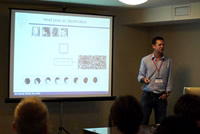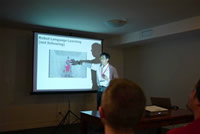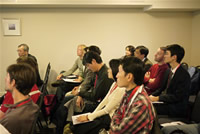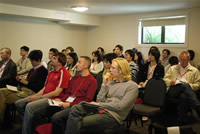

The International Workshop on Gaze Sensing and Interactions was held on November 8, 2010 in Queenstown, New Zealand in relation to the CREST research project, "Sensing and Controlling Human Gaze in Daily Living Space for Human-Harmonized Information Environments" (represented by Professor Yoichi Sato, The University of Tokyo; CREST research area, "Creation of Human-Harmonized Information Technology for Convivial Society").
This workshop was held in conjunction with "The Tenth Asian Conference on Computer Vision (ACCV2010)", an international meeting in the field of computer vision. There were two presentations by invited speakers from foreign countries along with seven research presentations which were selected through a double blind peer review process, making a total of nine presentations.
The first invited speaker, Dr. Ian Reid, introduced a method for discerning head pose using a Randomized Ferns algorithm and image features based on HOG and color information, as a way of estimating the gaze direction of rough human figures from low resolution images from, for example, surveillance cameras. Estimated information on head pose is used to visualize the focus of attention of a person from a surveillance camera image, for control of high resolution cameras in a multi-camera surveillance system, and for analysis of interactions between people.
The second invited speaker, Associate Professor Chen Yu, spoke on the importance of gaze information in human-robot interactions. He introduced results of experiments on measuring and comparing different types of information, including vision, by recording interactions between various combinations such as fellow humans, an adult and a child, a human and a robot, and a human and an avatar on a computer monitor, being based around the mutual performance of tasks. We were able to learn some extremely useful information on the realization of more natural interactions between humans and robots.
As for the groups participating in the actual CREST research project, we heard the results of an experimental assessment related to predictability of visual attention in visual saliency models of human egocentric visual attention from the Yamada group based at The University of Tokyo. In addition, the Hoque group from Saitama University reported on experiments related to a proposal for a human-robot interactions using gaze information.
Moreover, the Duchowski group based at Clemson University proposed a method of discerning scanpaths using heatmap representations and presented results of experiments related to distinguishing human scanpaths by circumstance (whether or not there is an explicit task) and by origin of generated data (recordings of humans and simulated data from the visual saliency maps). The Takatani group of Kobe University reported on the efficacy of introducing methods of parameter selection based on Akaike's Information Criterion, in relation to monocular camera based gaze estimation methods based on active appearance models. The University of Tokyo's Ozturk group proposed a method of gaze estimation from low resolution images based on the combination of head orientation estimation from flow analysis of SIFT feature values and template based human body orientation estimations. The Yamauchi group of Chiba University delivered a report on methods for the interactive display of high dynamic range images with real-time tone mapping using a user's gaze information. The Chi group based at the Chinese Academy of Science presented a comparative evaluation concerning gaze point coordinates and the predictability of gaze sequence within an image, in relation to the visual saliency map and a number of similar map models.
This workshop, with its theme of gaze sensing and interactions, accomplished a sharing of information and presentations of research covering a wide range of topics from gaze estimation technologies to robotics applications. In addition, with the workshop being held in conjunction with ACCV2010, for which expectations for presentations of especially high level research results run high even in comparison to the many other international conferences held in the field of computer vision, it was able to attract a large number of presenters and participants from not only Japan but various other countries, as well. Along with confirming the high level of interest in this research field, we were able to exchange extremely important opinions and ideas related to work currently underway and important research topics that should be dealt with by the research community as a whole. The workshop yielded extremely valuable results which will allow us to advance our work within the current research project.


JST, an integrated organization of science and technology in Japan, establishes an infrastructure for the entire process from the creation of knowledge to the return to the society. For more information, visit http://www.jst.go.jp/EN/